Ready in 15 minutes, my easy and mouthwatering Teriyaki Salmon recipe makes a light and savory meal on any weeknight. I’ll show you how to pan-grill the tender salmon fillets and make a homemade teriyaki sauce in the traditional Japanese method.
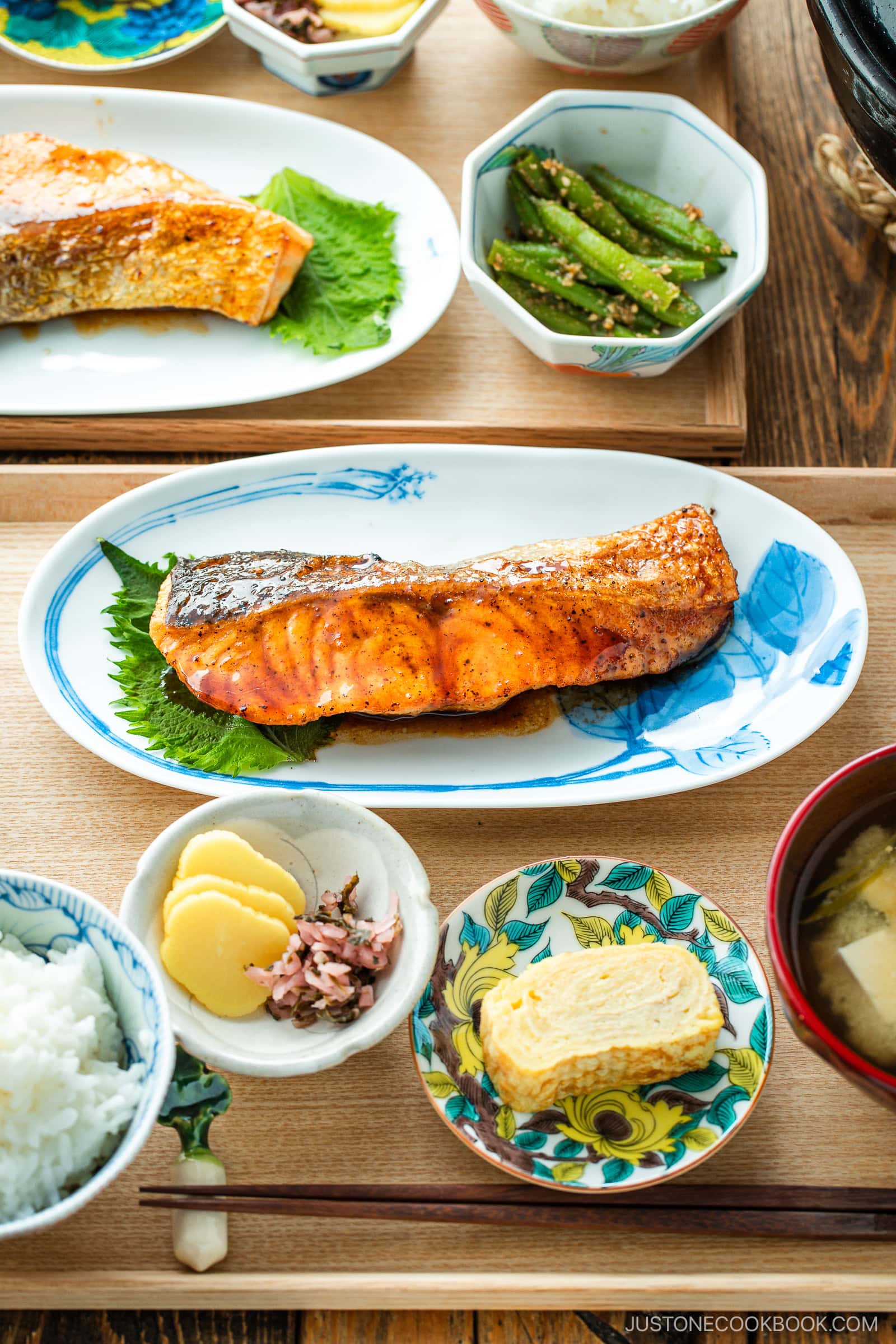
I grew up eating a variety of fish in Japan, and salmon was a favorite in our household. Today, I’ll share an authentic and easy Teriyaki Salmon recipe, just like we make at home. You’ll learn the secret to keeping the salmon juicy yet crispy and how to make a perfectly balanced sauce with just 4 ingredients!
Craving more salmon dishes? Try my Miso Salmon, Japanese Salted Salmon, and Salmon in Foil recipes next!
Table of Contents
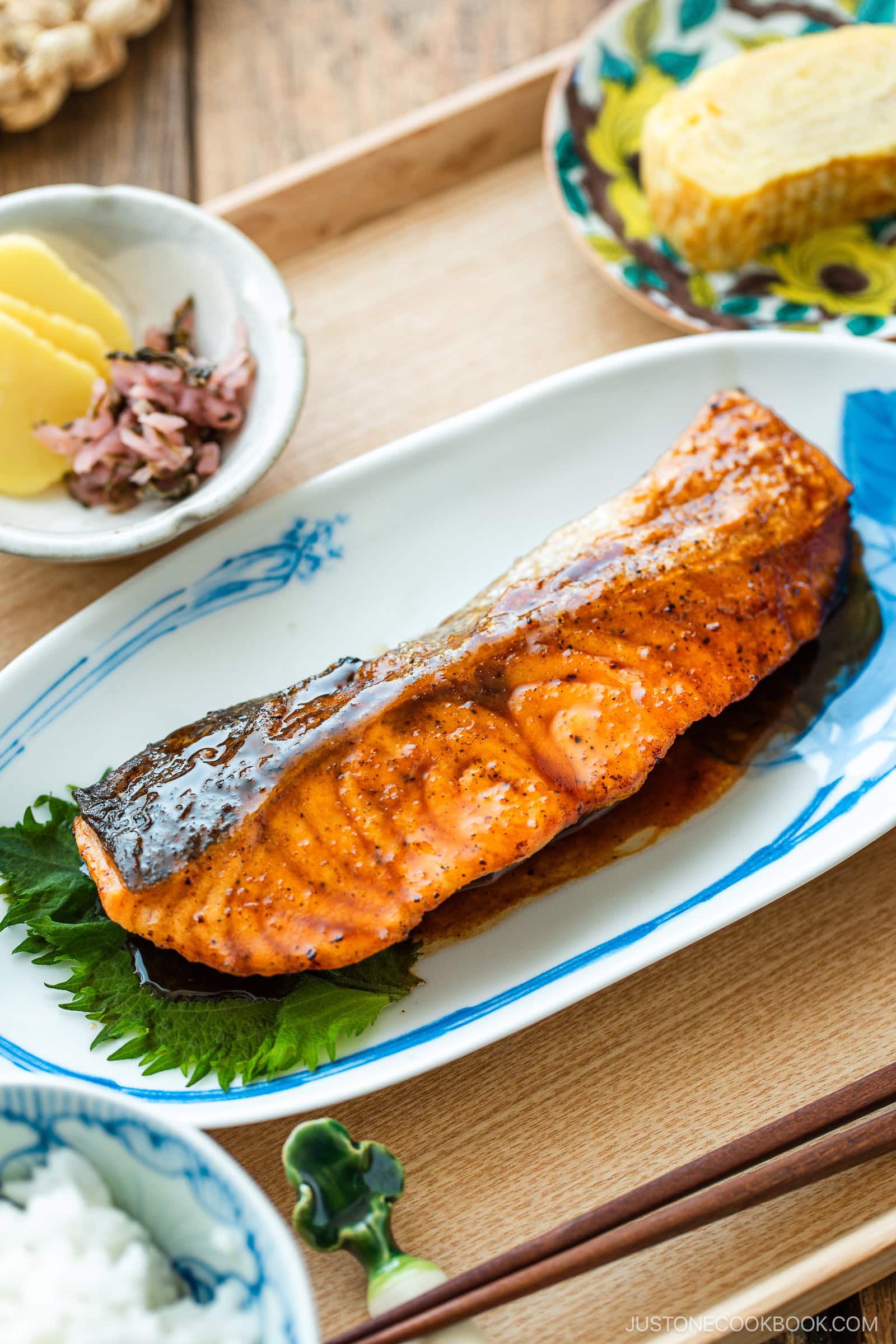
What is Teriyaki?
Teriyaki (照り焼き) in Japanese actually describes a cooking method that first appeared in Japan in the 1600s. Teri (照り) means luster, and yaki (焼き) means grilled, broiled, or pan-fried. It essentially refers to any food cooked this way that’s brushed with a shiny glaze called tare (タレ). Outside Japan, both the cooking style and sauce are commonly called teriyaki.
Salmon, chicken, yellowtail (hamachi), pork, and tofu are the most popular ingredients to cook teriyaki-style in Japan. Home cooks pan-fry them instead of cooking in an oven.
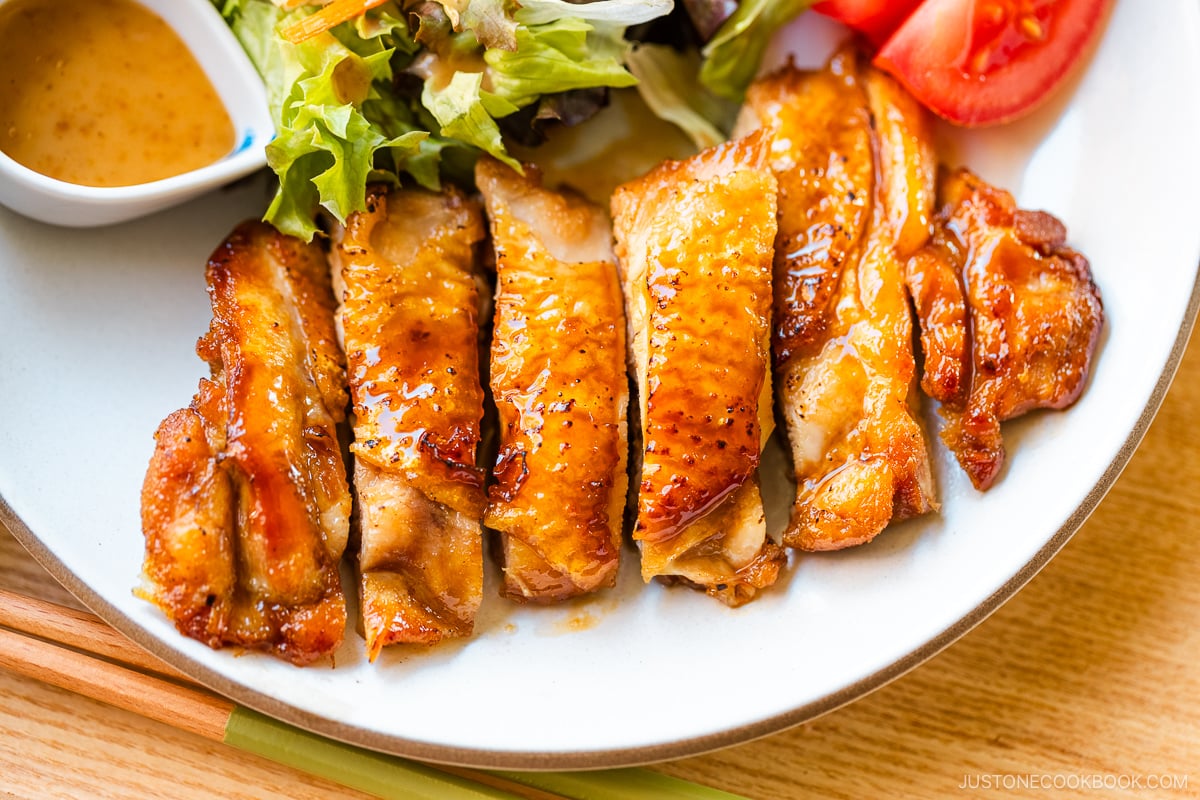
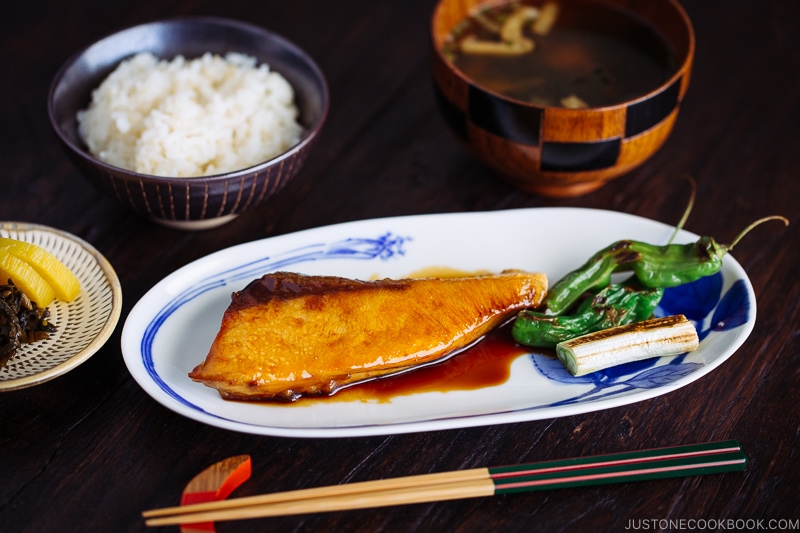
Why I Love This Recipe
- It’s easy and no fuss! Pan-grill the fillets until golden brown outside and juicy inside, then finish it off with a sweet-savory homemade glaze. I love the simplicity of this delicious, one-pan dish.
- Ready in just 15 minutes – Japanese-style salmon filets are thinly sliced to cook fast in the pan. Read more in Nami’s Recipe Tips.
- Uses a traditional sauce with 4 ingredients – Most Japanese teriyaki recipes use only soy sauce, sake, mirin, and sugar (optional). For the best taste, we typically prepare a simple sauce from scratch.
- No marination needed – For the perfect seasoning, you only need the glaze that’s reduced in the pan. It allows the delicate flavor of the salmon to shine through without overwhelming it.
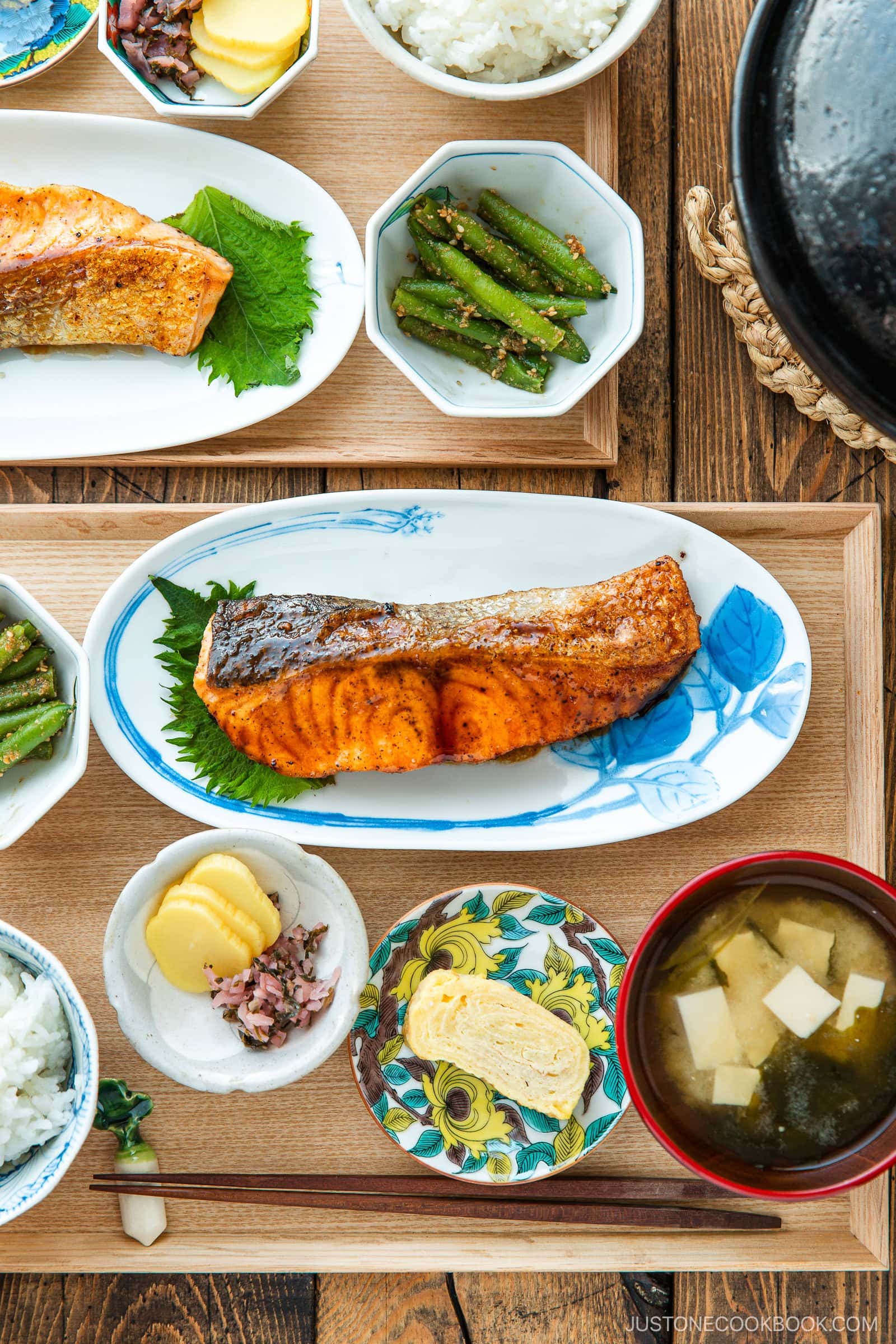
Ingredients for Teriyaki Salmon
- Skin-on salmon fillets – ¾ inch (2 cm) thick
- Salt and freshly ground black pepper
- All-purpose flour – for coating the salmon
- Cooking oil and unsalted butter
- Sake – for steaming
- Homemade teriyaki sauce:
- Sake
- Mirin
- Soy sauce
- Sugar
Find the printable recipe with measurements below.
Jump to RecipeSubstitutions
- All-purpose flour: Use cornstarch or potato starch for gluten-free.
- Sake: You can substitute Chinese rice wine, dry sherry, or water.
- Mirin: If you can’t find it, substitute 1 Tbsp sake (or water) + 1 tsp sugar for every 1 Tbsp mirin. The flavor won’t be the same, but it’s close.
- Soy sauce: Use gluten-free soy sauce or tamari if needed.
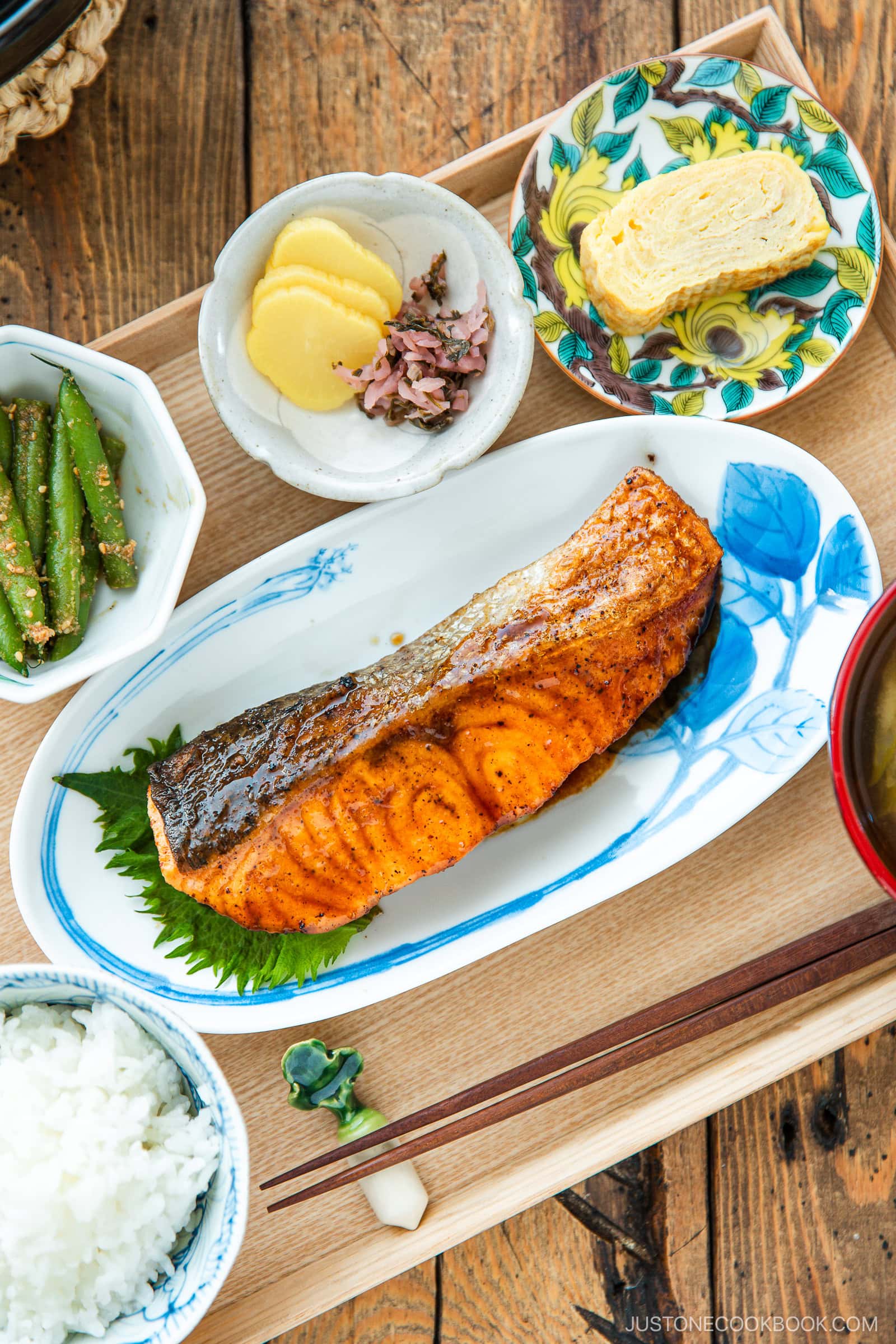
How to Make Teriyaki Salmon
Preparation
Step 1 – Prepare the sauce and salmon. Whisk together the sauce ingredients. Season both sides of the salmon with kosher salt and ground black pepper and coat evenly with flour.
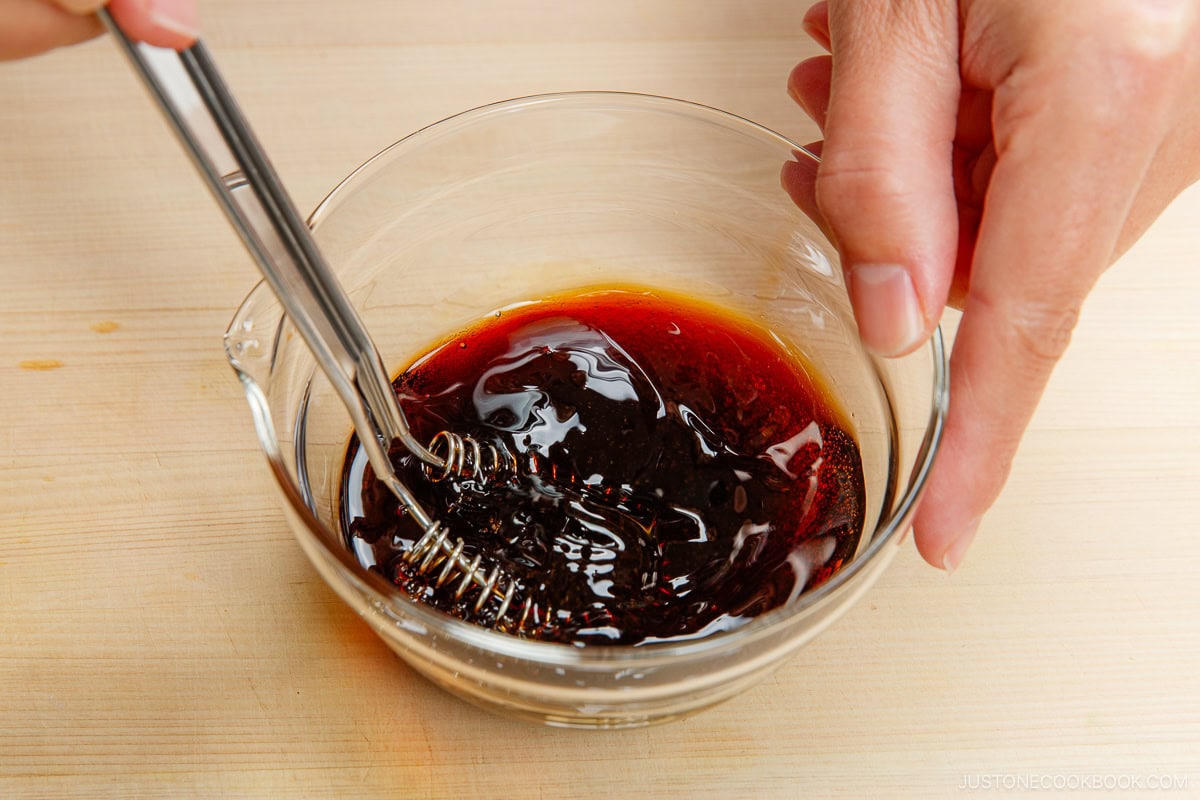
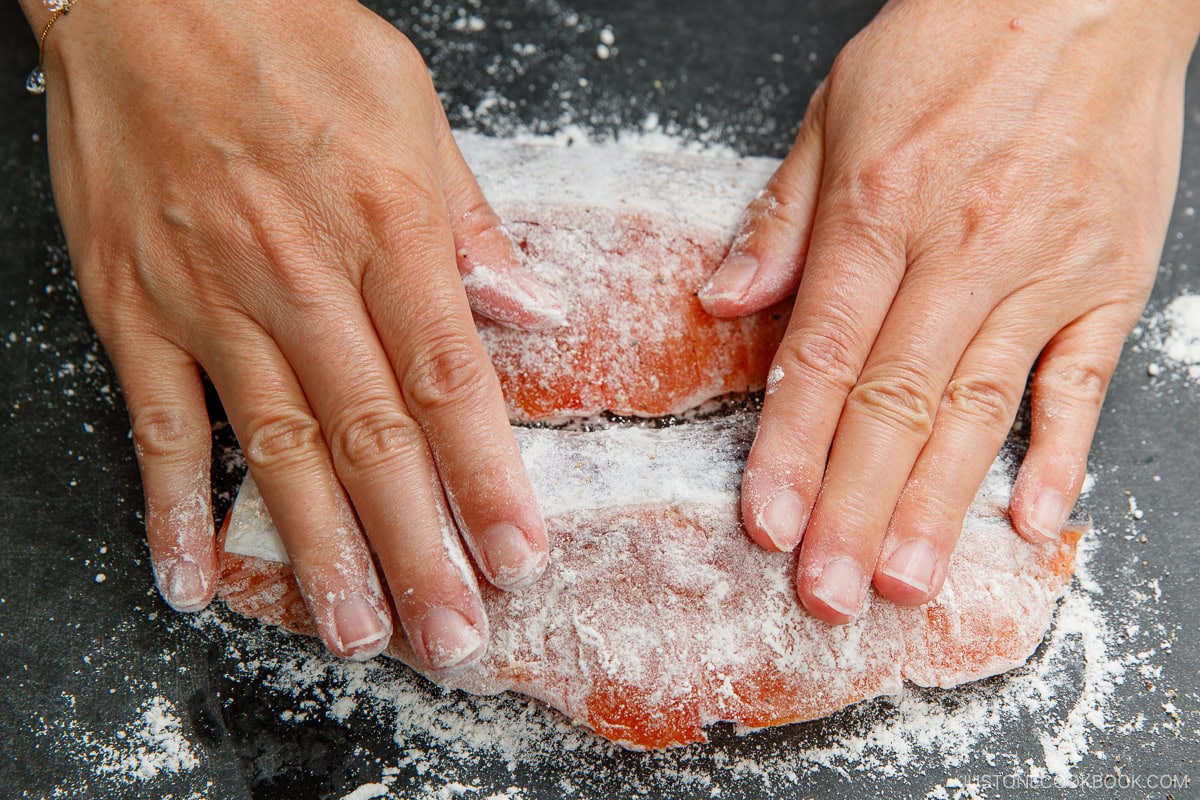
Cooking
Step 2 – Cook. Heat a pan over medium heat, then add oil and butter. Sear the skin against the hot pan‘s surface for 15 seconds then lay the fillets skin side down. Cook until golden brown, and then flip over.
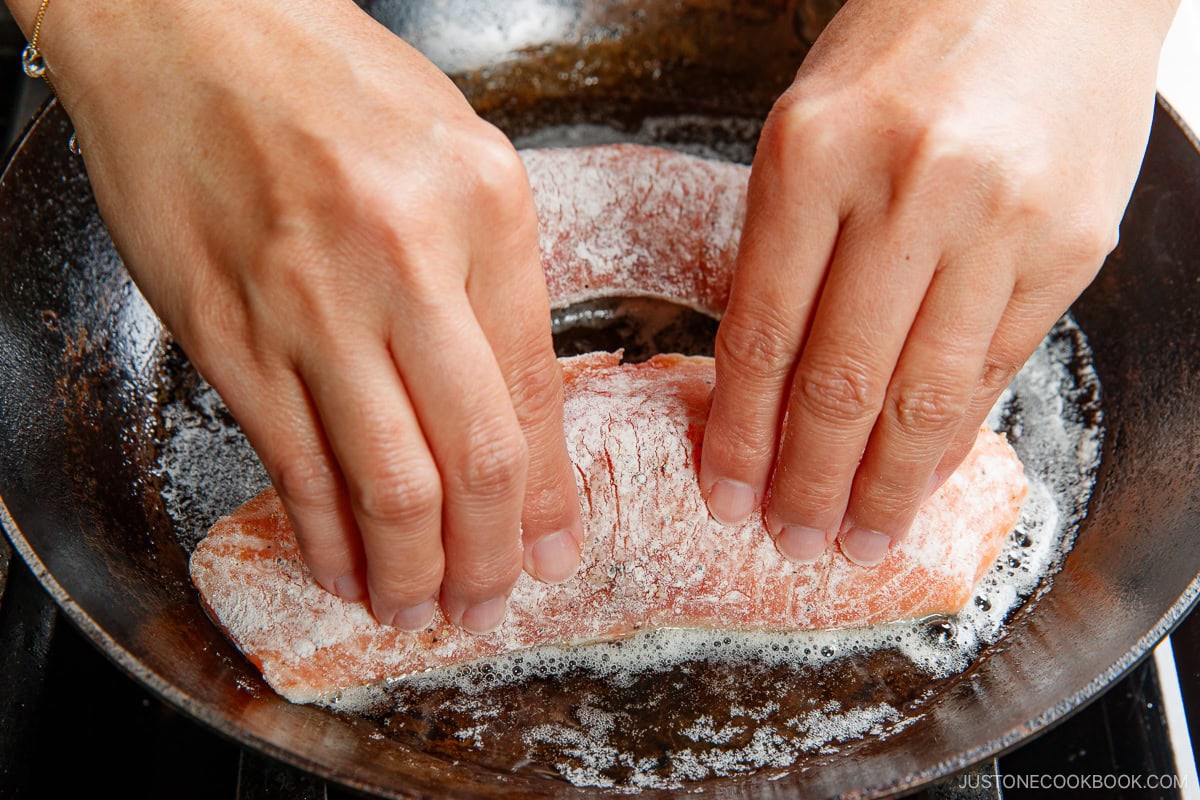
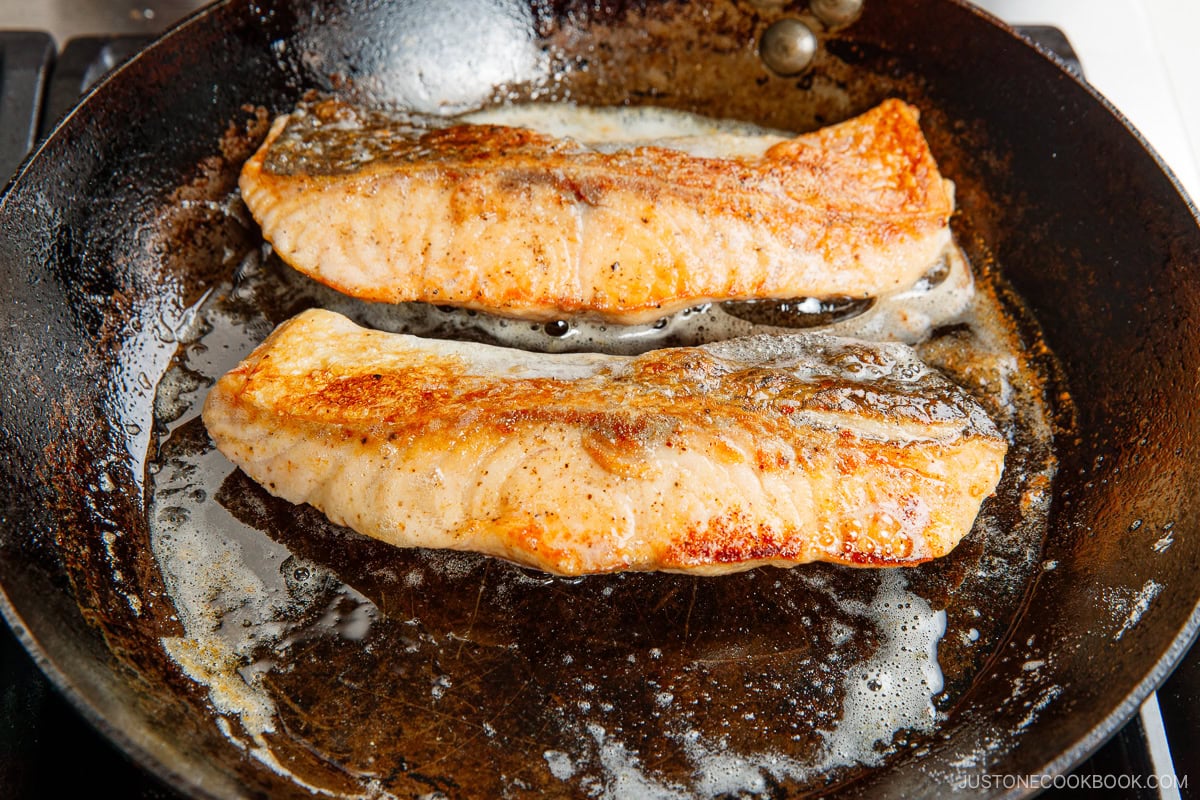
Step 3 – Steam. Add the sake and cover the pan. Reduce the heat to low and steam for 3–5 minutes or until the internal temperature registers 125–130°F (52–54ºC). Transfer to a plate.
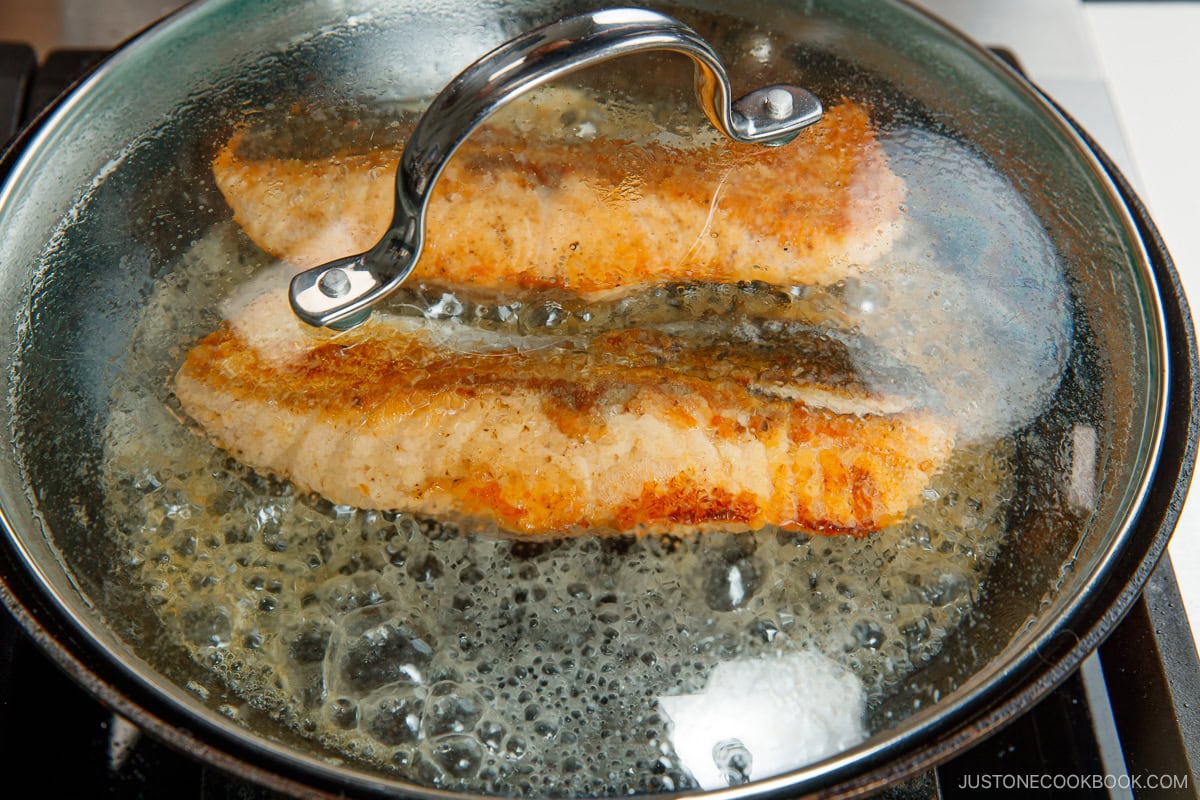
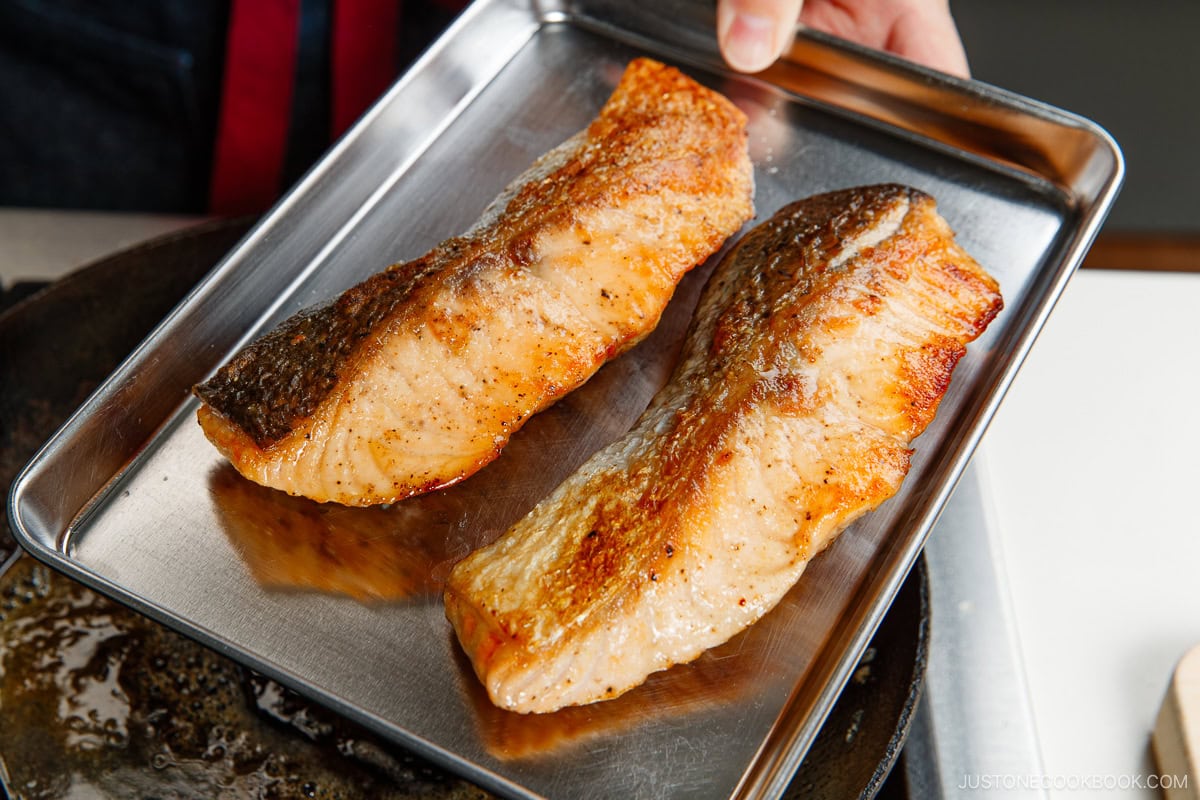
Step 4 – Simmer the sauce, then glaze the salmon. Coat the salmon with the hot sauce. Reduce and thicken the glaze, then turn off the heat.
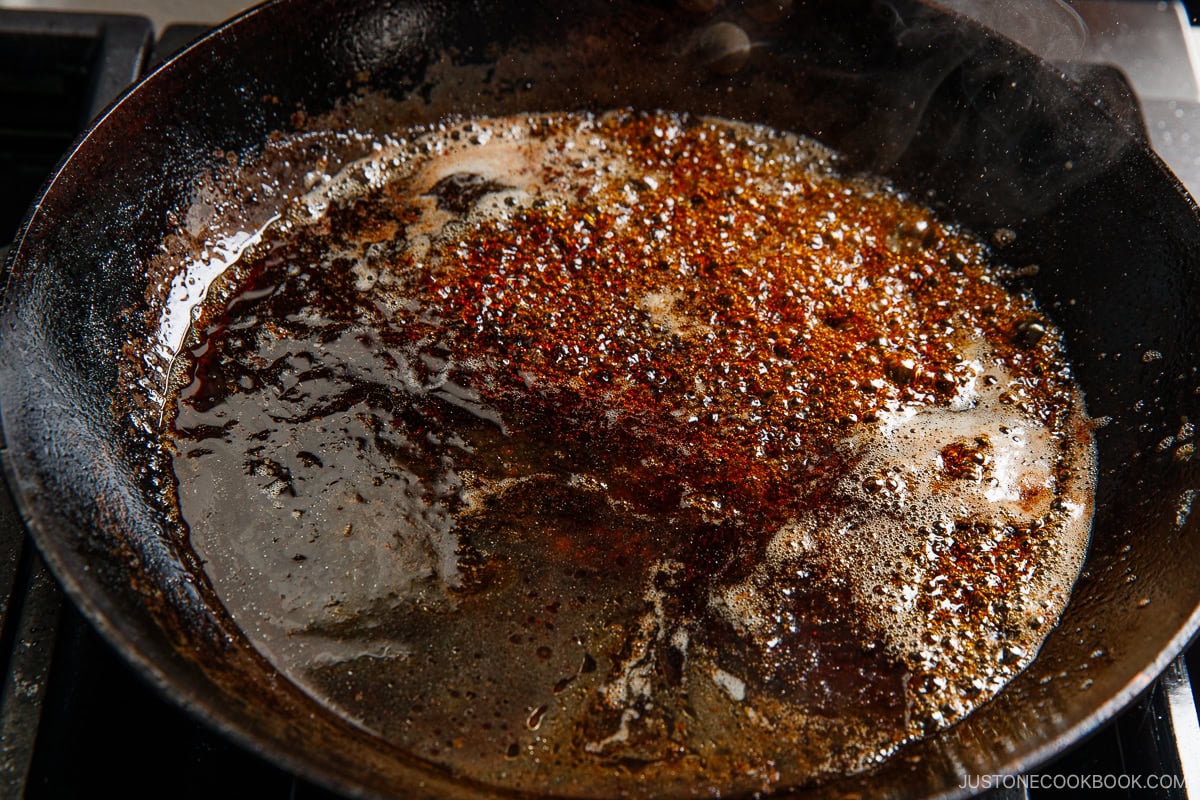
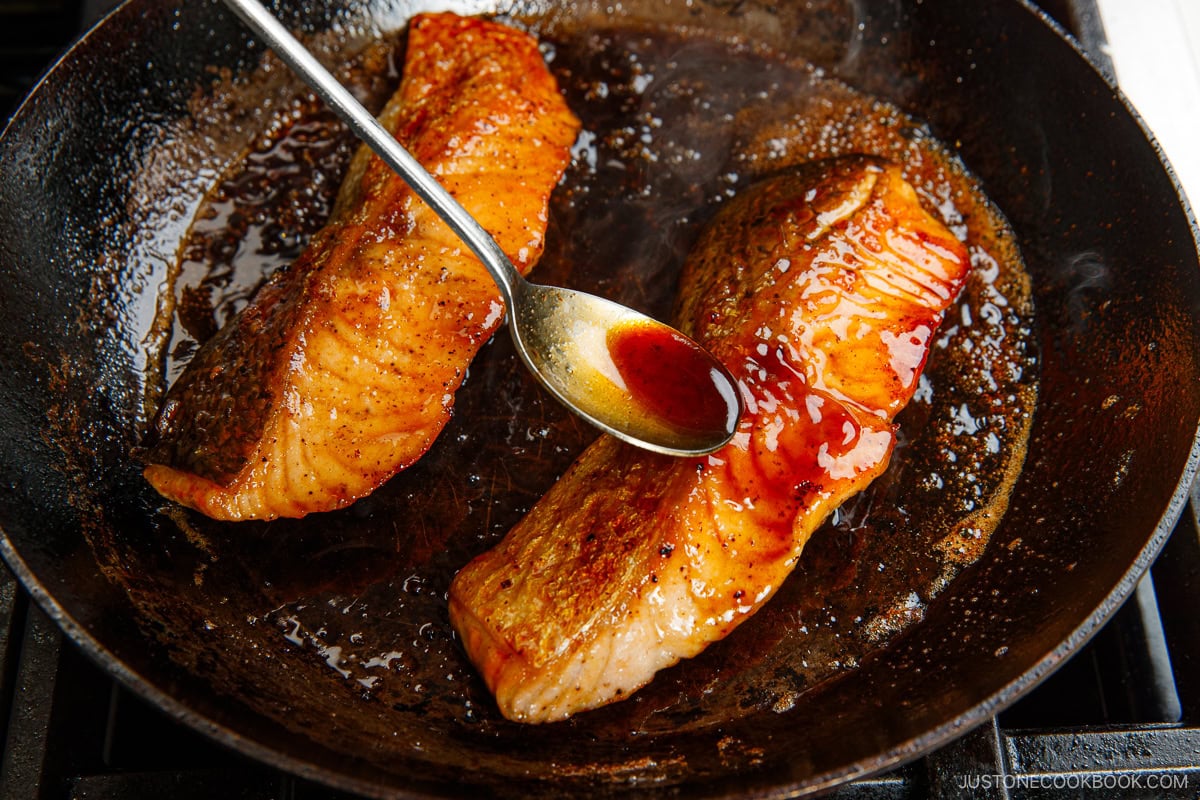
Step 5 – Serve. Drizzle with pan sauce and serve the teriyaki salmon as a main dish to your meal.
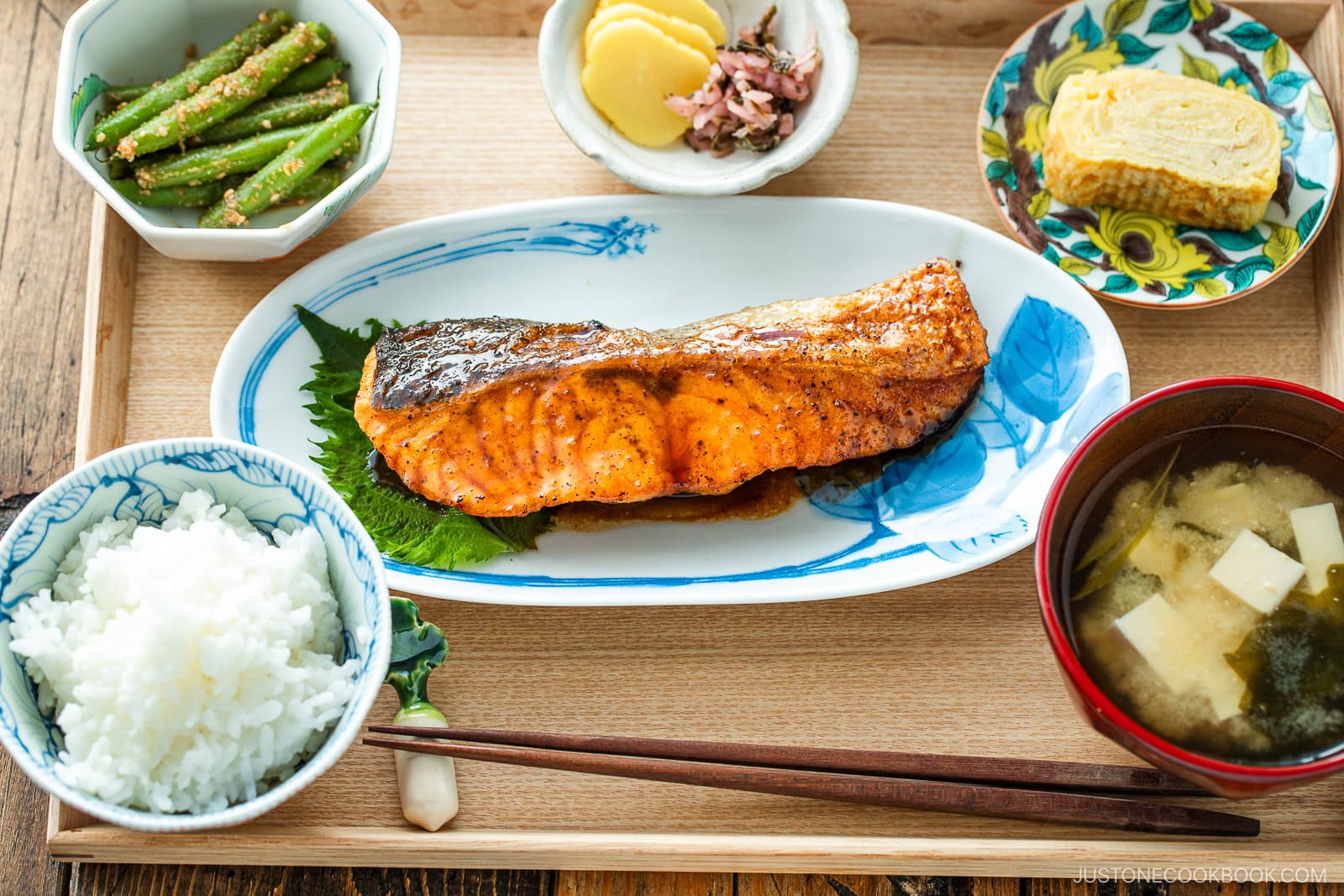
Nami’s Recipe Tips
- Use thin, Japanese-style salmon fillets – Use skin-on fillets sliced thin and diagonally, about ½ to ¾ inch (1.3-2 cm) thick. This helps prevent overcooking, keeps the salmon juicy, and lets it absorb the seasoning faster. In the US, you can find them sold at Japanese grocery stores. If you buy a whole side of salmon, check out my tutorial on How to Cut Salmon into Japanese-style Fillets.
- Coat the salmon evenly with flour. This is the secret to juicy salmon! The flour creates a protective layer that locks in the umami and juices while helping the sauce to thicken and absorb better. For a gluten-free option, use cornstarch or potato starch.
- Sear the salmon skin first before laying it down. The skin is so delicious when it’s crispy. Hold the fillet and press the skin against the hot pan for 15 seconds.
- Place the presentation side (skin side) down into the pan first. The side that hits the pan while it is clean gets the best browning.
- Check the internal temperature with a digital thermometer. Use an instant-read thermometer and cook to an internal temperature of 125–130°F (52–54ºC) at the thickest part. This takes out the guesswork so the salmon cooks perfectly every time.
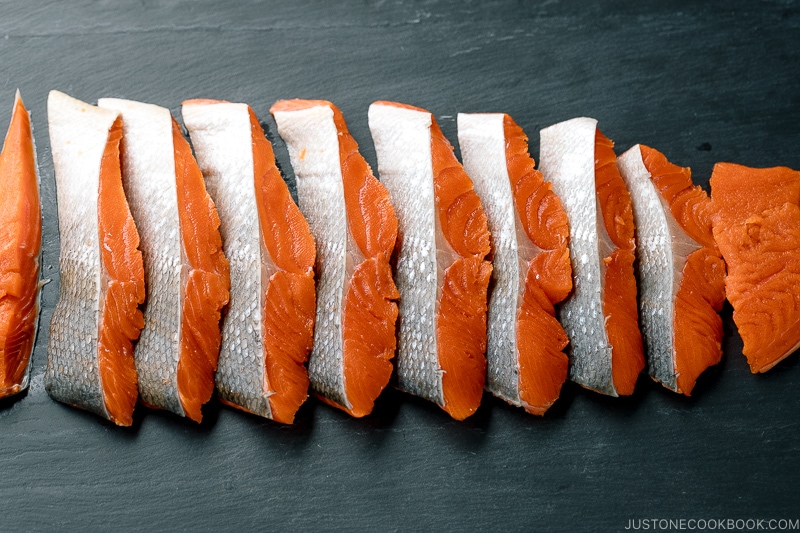
Variations and Customizations
- Play with the sauce ratios. In Japanese cooking, we commonly adjust the seasonings to taste. For example, you can use less or low sodium soy sauce and reduce the amount of sugar accordingly by a teaspoon or so.
- Try a different fish. You can use this same cooking technique to make Yellowtail Teriyaki, a classic Japanese grilled fish recipe.
- Make it vegan/vegetarian. Crispy outside, soft inside—my Teriyaki Tofu offers a delicious textural contrast.
- Try it with chicken. You could skip the salmon and go straight to my Chicken Teriyaki and Teriyaki Chicken Meatballs recipes.
What to Serve with Teriyaki Salmon
Teriyaki salmon pairs perfectly well with many different side dishes. For a healthy Japanese-style weeknight dinner, I like to serve it with a vegetable side dish, soup, and steamed rice. Here are some suggestions I think you’d like:
- With a vegetable side – This dish goes well with refreshing veggies like Green Bean Gomaae (Sesame Dressing) or pan-seared asparagus.
- With a salad – Japanese Potato Salad is always a good choice.
- With soup – You can’t go wrong serving classic Homemade Miso Soup.
- With a Japanese rolled omelette – A slice or two of Tamagoyaki rounds out the meal!
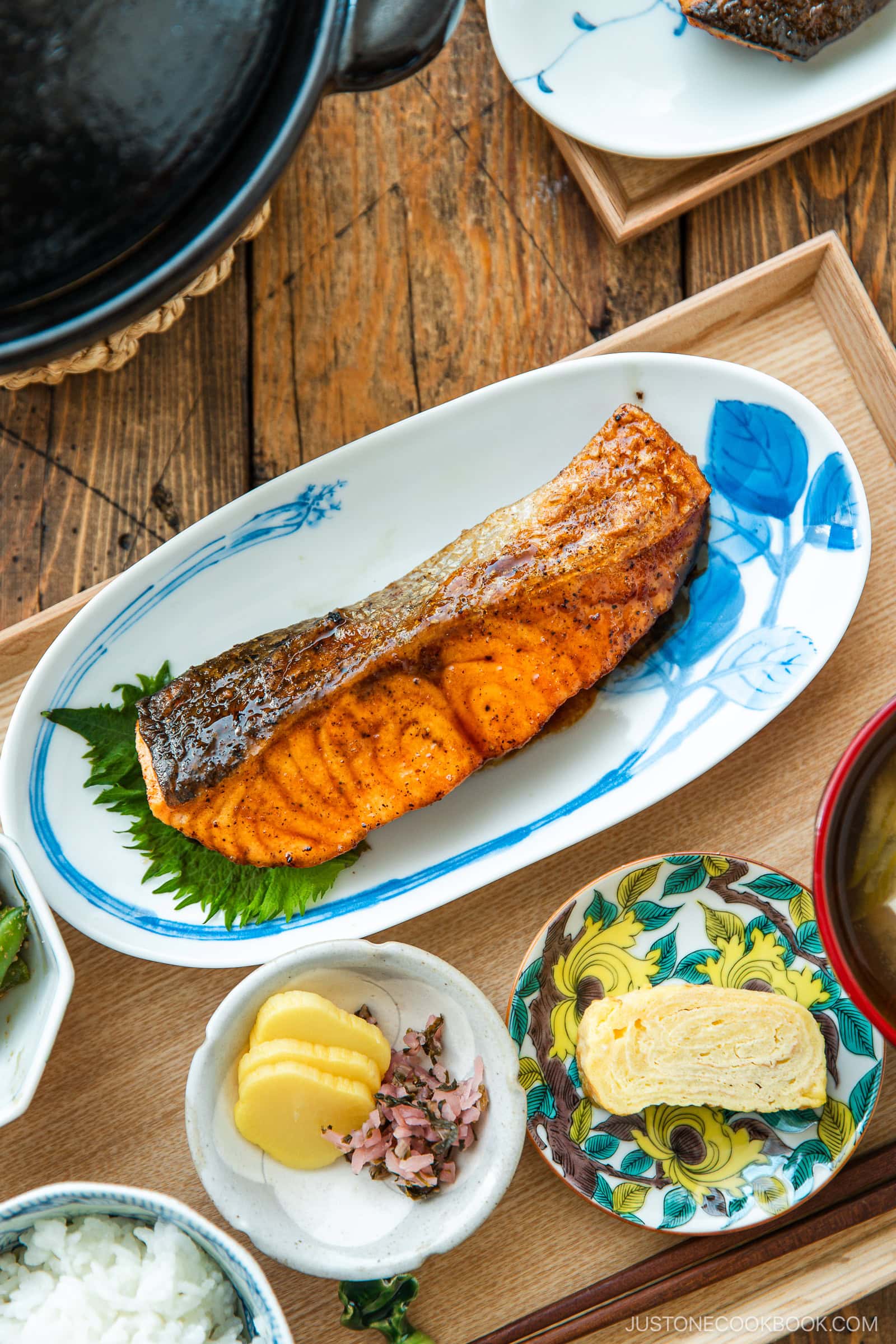
Storage Tips
Did you know that you can do a lot with leftover teriyaki salmon? I love it in Teriyaki Salmon Bento, on a rice bowl, on Ochazuke (Green Tea Over Rice), or with noodles. It’s also great in Teriyaki Salmon Onigirazu (Rice Sandwich).
To store: You can keep the leftovers in an airtight container and store in the refrigerator for up to 3 days and in the freezer for 2 weeks.
Frequently Asked Questions
Many non-Japanese recipes include ingredients like rice vinegar, honey, brown sugar, sesame oil, sesame seeds, hoisin sauce, green onion, or garlic. While these can be flavorful, they’re not part of traditional Japanese teriyaki sauce.
For extra depth, I sometimes add grated ginger or onion, but never rice vinegar, sesame oil, or hoisin sauce. Some use a cornstarch slurry to thicken the sauce, but it’s unnecessary—simmering naturally reduces and thickens it, and the flour (or starch) on the fish helps as well.
Follow the baking method from my Miso Salmon recipe. Make the teriyaki sauce separately and brush it on the salmon multiple times while baking for 10–15 minutes.
Japanese-style salmon fillets are thinner than typical US cuts, so they cook faster. For perfect results, use an instant-read thermometer and cook to 125–130°F (52–54ºC) at the thickest part.
Yes, you can adjust the sugar to your taste. I recommend keeping some sweetness to balance the soy sauce’s saltiness. You can also use honey or maple syrup, but be careful—they burn easily.

Teriyaki Salmon
Video
Ingredients
For the Teriyaki Sauce
For the Salmon
- 2 skin-on salmon fillets (¾ lb, 340 g; ¾ inch (2 cm) thick)
- ¼ tsp Diamond Crystal kosher salt
- ⅛ tsp freshly ground black pepper
- 1 Tbsp all-purpose flour (plain flour) (use cornstarch or potato starch for gluten-free)
- ½ Tbsp neutral oil (for cooking)
- 1 Tbsp unsalted butter (for cooking)
- 1 Tbsp sake (for steaming; you can substitute Chinese rice wine, dry sherry, or water)
Instructions
- Gather all the ingredients.
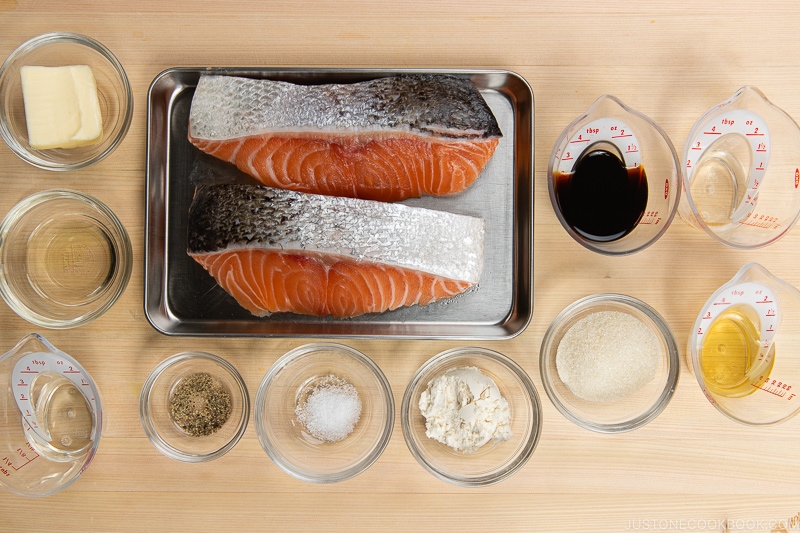
To Make the Teriyaki Sauce
- In a microwave-safe bowl, combine the ingredients for the teriyaki sauce: 1 Tbsp sake, 1 Tbsp mirin, 2 Tbsp soy sauce, and 1 Tbsp sugar. Mix well to dissolve the sugar.
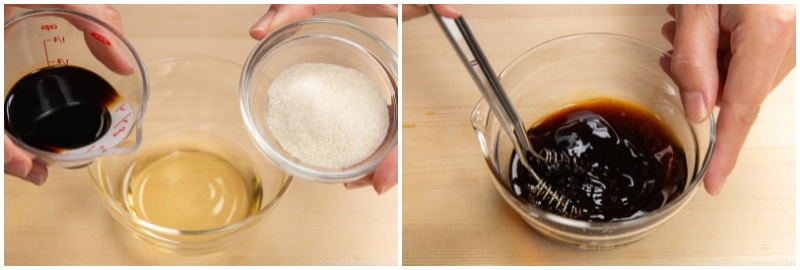
- To help dissolve the sugar, you can microwave the mixture for 30 seconds.
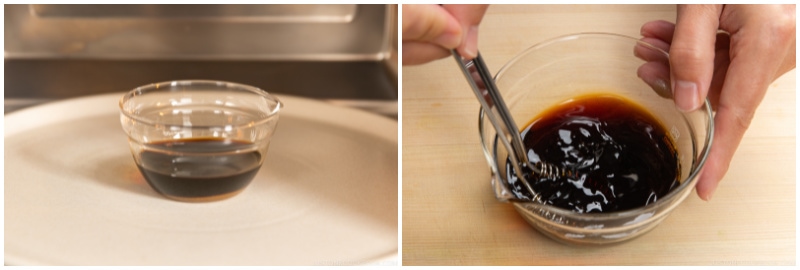
To Prepare the Salmon
- Rinse 2 skin-on salmon fillets and pat dry. Season one side with some of the ¼ tsp Diamond Crystal kosher salt and ⅛ tsp freshly ground black pepper. Tip: The salmon skin will hold the flesh together while cooking.
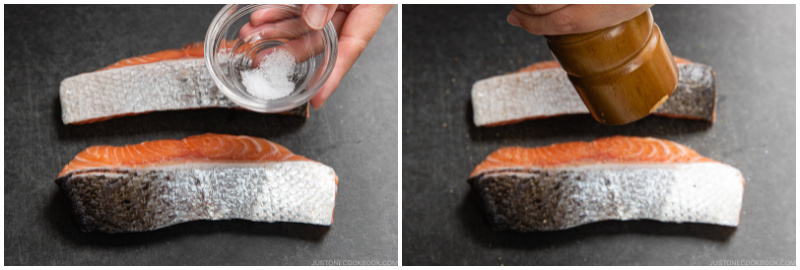
- Flip over and season the other side with the remaining salt and black pepper.
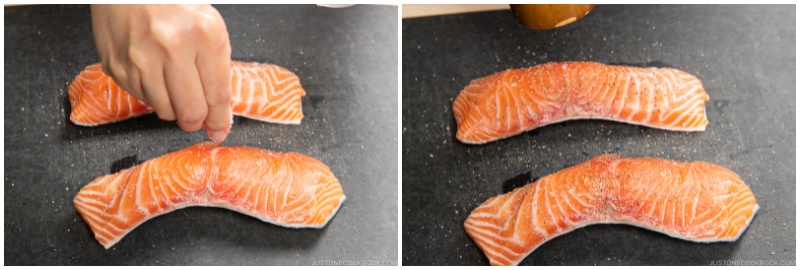
- Sprinkle half of the 1 Tbsp all-purpose flour (plain flour) on one side of the salmon and coat evenly. Tip: Coating the salmon with flour helps retain its umami flavor and juiciness. It also helps absorb the sauce and thickens it.
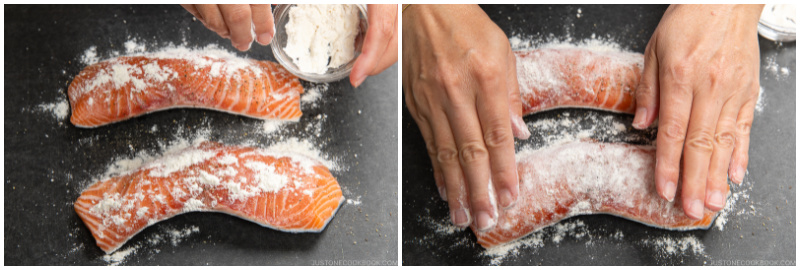
- Flip over and sprinkle the rest of the flour on the other side. Gently press it to adhere, then remove the excess flour.
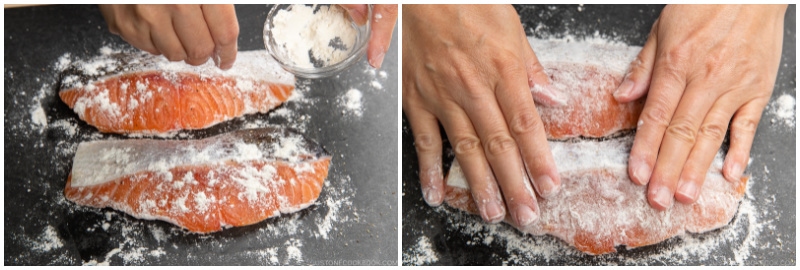
To Cook the Salmon
- Heat a frying pan over medium heat. When hot, add ½ Tbsp neutral oil and 1 Tbsp unsalted butter. Do not burn the butter. If the pan gets too hot, reduce the heat or move the pan off the heat temporarily. Next, sear the salmon skin: One fillet at a time, press the skin against the hot pan‘s surface for 15 seconds before laying the fillet skin side down in the pan. Repeat with the other fillet. Tip: The presentation side (the skin side) should go into the pan first because you will get the best browning on the first side that hits the clean pan.
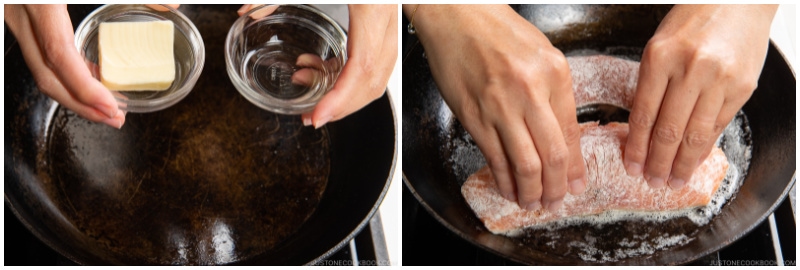
- Cook the salmon for 3 minutes until the bottom is golden brown, and then flip.
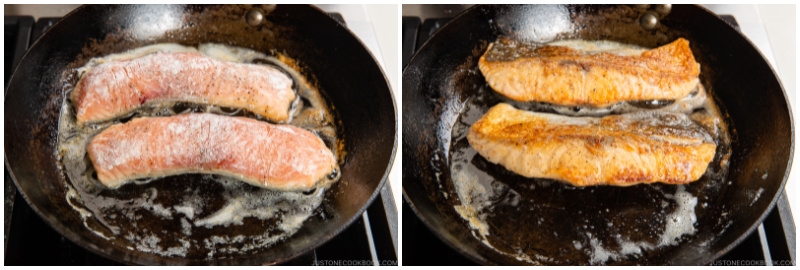
- To the pan, add 1 Tbsp sake—1 Tbsp for thin fillets and no more than 2 Tbsp for thicker fillets. Cover the pan with a lid and reduce the stove‘s heat to low. Steam the salmon for about 3–5 minutes, depending on the fillet thickness. If the sake has evaporated but the salmon isn‘t cooked through yet, add another tablespoon of sake and continue steaming.
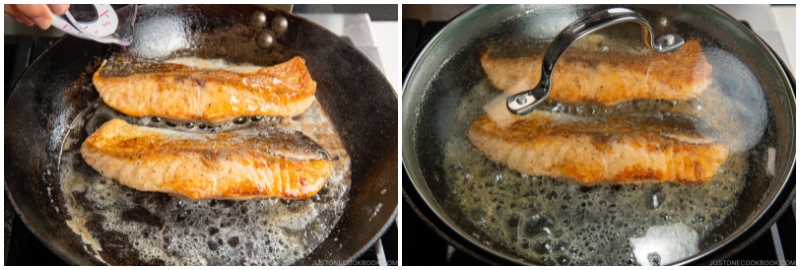
- Cook the salmon until it registers an internal temperature of 125–130°F (52–54ºC) at the thickest part of the fillet (I use a Thermapen instant-read thermometer). Then, transfer the salmon to a tray or plate. These fillets were about ¾–1 inch (2–2.5 cm) thick and took roughly 4 minutes to cook. Tip: The USDA recommends cooking fish to an internal temperature of 145°F (63ºC); however, the residual heat will continue to cook the salmon, so you must remove the fillets at 125–130°F (52–54ºC) to avoid overcooking.
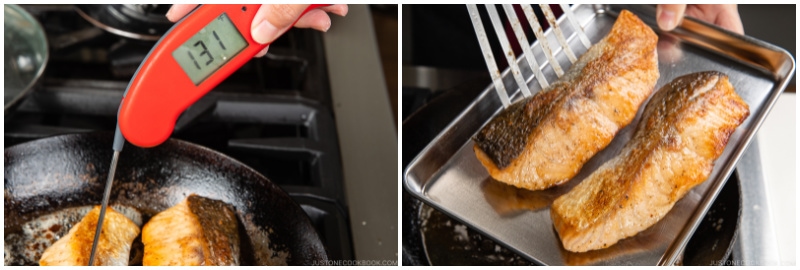
- Add the teriyaki sauce ingredients to the pan and increase the heat a bit. When the sauce starts to boil, add the salmon back to the pan.
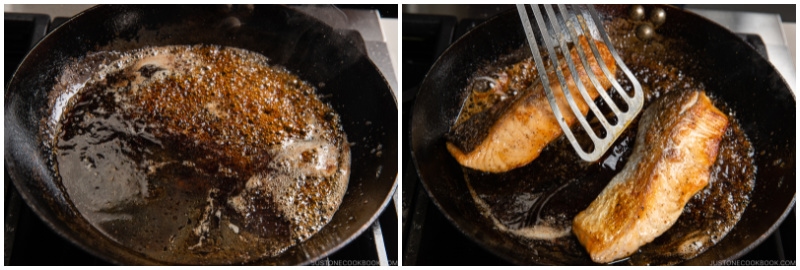
- Spoon the sauce over the salmon. When the sauce thickens, turn off the heat. Transfer the salmon to a plate and drizzle the sauce on top.
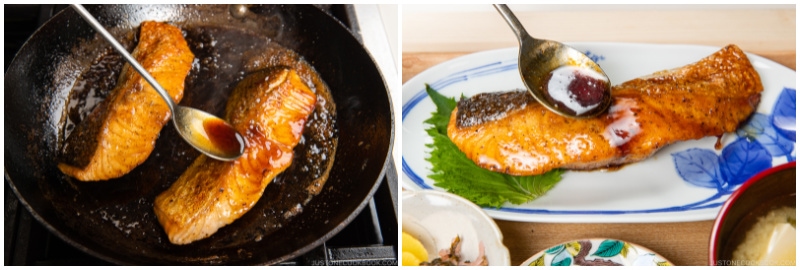
To Serve
- Serve immediately. I like to serve my Teriyaki Salmon as part of a Japanese-style meal with Green Bean Gomaae (Sesame Dressing) or pan-seared asparagus, Tamagoyaki, Homemade Miso Soup, and Steamed Rice. Other side dishes that pair well with this savory-and-sweet salmon include Spinach with Sesame Miso Sauce, Japanese Potato Salad, Blanched Broccoli with Sesame Oil, Green Bean with Crumbled Tofu and Sesame, Brussels Sprouts with Bacon, and Roasted Cauliflower Kale Salad.
To Store
- You can keep the leftovers in an airtight container and store in the refrigerator for up to 3 days and in the freezer for 2 weeks.
Nutrition
Editor’s Note: This post was originally published on April 25, 2013. It was updated with new step-by-step images and the final images in March 2022, with a new video on October 13, 2023, and republished with more helpful content on February 6, 2025.
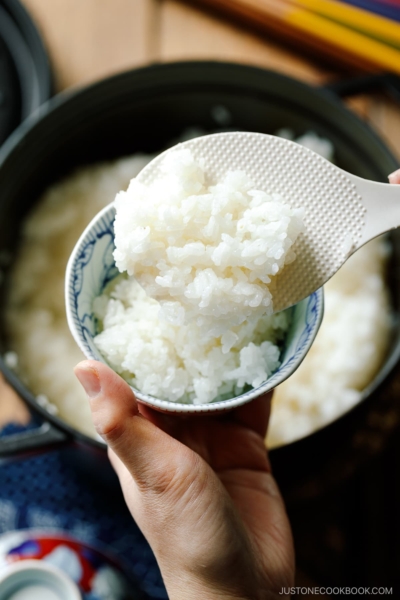
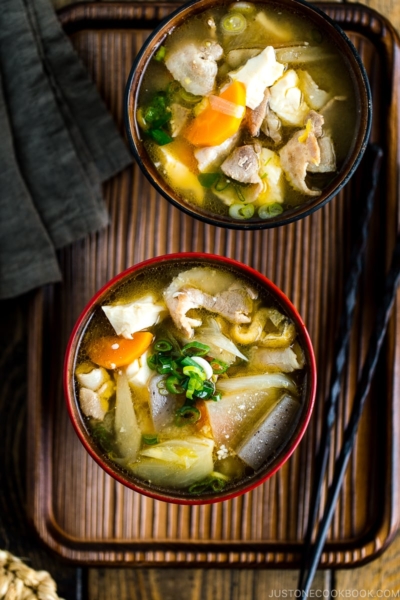
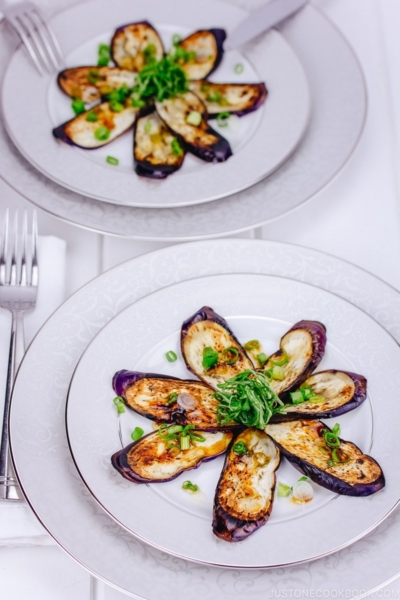
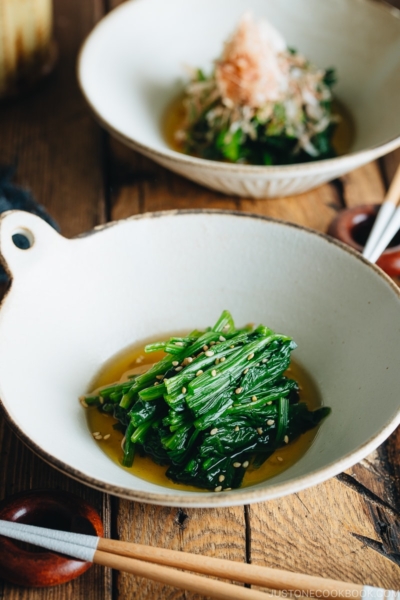




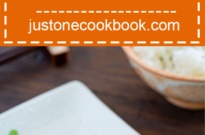
Hi Nami!
Thank you for this recipe! It was absolutely delicious!!
Quick question– I ensured that I crisped up the skin, and the skin definitely helped the fillet stay in shape. My only issue was that when I was eating, the skin completely pulled off, so I was left with a big piece of skin left on my plate (which could seem unappetizing to some…) Is there a way that I would be able to make the skin stay on as one with the flesh? Should I crisp up the skin for a longer time? Thank you in advance!!
Hi Sky! Without seeing an image, from what you described, it sounds like the cut of salmon you used came with a large surface of skin. Try to get different cut, or if you cut the salmon yourself, cut differently. Typically Japanese fillet has a thin and long strip of skin. Hope this helps. 🙂
Hi Namisan! This recipe is great. I studied Japanese in school and your blog is an excellent reference to continuing my studies through cooking. I swear by using ingredients that are authentic as possible.
My cuts of Salmon seemed thicker than yours, but they cooked just great. Perfectly flaky by your simple instructions. Neither me nor my boyfriend are huge fish eaters, but this dish is AMAZING! I served it with garlic kale and sautéed asparagus. It was a huge success. I will definitely be making this again. The glaze perfectly salutes the salmon flavor. Totemo Oishii!
I love your blog!
Hello John! Thank you so much for trying this recipe! I’m so happy to hear you liked it. It’s very simple to make too. 🙂
ブログフォローして下さって、どうもありがとう!
This is the second time I’m making it! your recipe was quick simple and pure brilliance! The boyfran loves it and so do I! 🙂 Thank you so much!
Thank you so much for trying this recipe and I’m so happy to hear you and your boyfriend are enjoying this dish! You two just made my day! 🙂
I made this recipe with a different cut of salmon, it was delicious. Thanks!
Hi nhms! I’m so happy to hear you liked this recipe! Thank you for your kind feedback. 🙂
Hi Nami, I tried the teriyaki salmon tonight and my family said it tasted good. I love the sake taste. However the fish and the sauce turned out to be abit oily even though I only 1tbsp of oil without butter.
Do you think it will be ok if no oil & butter at all? Will it turn out very dry?
Hi Jackie! Sure, you can omit oil and butter. If the salmon itself has nice fat (which is I think why yours turned out oily), it shouldn’t be dry. 🙂
Thank you for the recipe! 🙂 It was easy to make and wonderfully delicious. As a college student, I’m always looking for simple yet yummy dishes, and this one definitely hits the mark.
Hi Ali! Thank you so much for your feedback! I’m so glad you enjoyed this recipe! I hope to share easy and simple recipes that you can enjoy. 🙂
I have several teriyaki salmon recipes and this one of yours just took over as the best one yet. Made it last night, quick, easy & oh so delicious!
Hi Kathi! Aww I’m so glad you liked this recipe. You just made my day! 🙂
that’s true,homemade teriyaki sauce tastes better than the commercial ones sold in supermarket. Thank you for your recipes.
Thank you for your kind feedback, Chris! 🙂
making this tonight!!
Hi Charlotte! I hope you enjoyed this dish. 🙂
This looks delicious! I have to try it soon! –Would you be able to substitute the flour with potato starch with the same effect?
Hi Maia! Yes, you can use potato starch. You will get a little more crispier texture after you pan fry and sauce will thicken more too. Hope you will like this recipe! 🙂
Hi can you other fish fillets like basa ?
Hi Holland,
Sure! Other fish like Basa, yellowtail are good choices for teriyaki.
You may want to check out this recipe too. https://www.justonecookbook.com/catfish-kabayaki/
I hope this is helpful.😊
where can we buy the sake and mirin?? do regular grocery markets sell them?
Hi Hera! I’m not sure where you live, but if you are in the US, I’m pretty certain that you can buy them at Whole Foods and gourmet supermarkets. In my area, regular supermarkets carry them in Asian/International food isle. Asian grocery stores also carry it.
For the brand I use, you can click the link in the recipe and see some photos. Hope that helps! 🙂
Thank you! You see, I’ve been trying to think of a good dinner idea for my mom on Mother’s Day and this one just looks so delicious! However, I do have a problem…I’m still a minor (only 17)…Would they let me buy the sake? Aren’t sakes considered alcoholic beverages? If I can’t, are there any alternatives I can use for this?
Hi Hera! Okay then you cannot buy real sake. However, you can buy “cooking sake” which is not considered alcoholic beverages (because it has other ingredients that it’s not drinkable). Cooking sake is cheaper too, but it’s not pure sake and some people prefer avoiding “extra” ingredients (for example, real chefs may not use cooking sake). For this recipe, you can also omit or use water instead. Your mom is so lucky to have a daughter who cooks on Mother’s Day! 🙂 Good luck!
Made this for lunch and my goodness it is like heaven in my mouth! My coworkers were envious of me too. Thank you for sharing this recipe!
Hi Daisy! Really happy to hear you enjoyed it. You have a nice meal from lunch (I always eat leftover…)! 😀 Thanks so much for writing your feedback and making my day!
Nami, I made this last night! Thanks to your easy step by step photos it came out delicious!! (And it was a good way of using up the Sake on hand. Lol.)
Anyways, I made it with just frozen salmon fillets but when the Boyfriend comes over I can’t wait to try my hand at the fish market and buy some LEGIT fish! Lol.
Thanks for sharing!!!
Hi E! So happy to hear you enjoyed it! Haha, great that you could use sake! We use a lot of sake for cooking (to marinade, to steam (like this recipe), and to clean fish/meat…). Hope your BF will enjoy it too! Thank you so much for your feedback. 🙂
Made this tonight. Such a satisfying meal and so easy to make! Thanks for sharing. Will make this again.
Hi Daphne! So glad to hear that! Thanks so much for trying my recipe!
First of all thanks for making me a star among my family and friends ever since I discovered your recipes. Everybody loves them 🙂 One question for this recipe though: in step 4, do you flip the salmon over in the middle of the 3 minutes, or do you fry it only on the skin side for full 3 minutes?
Hi mengami! Thank you for your kind feedback. I’m glad your family and friends enjoyed my recipes. 🙂 Yes, you cook 3 minutes WITHOUT cover, and then next 3 minutes WITH the lid after you pour sake. 🙂 It’s 3 minutes for that thickness of salmon and the heat I use. So please adjust the time according to the heat, thickness of your salmon, etc. 🙂
Hi Nami,
The salmon is beautifully photographed.
Can skinless salmon fillets be used? Do you cook the salmon 3 minutes per side? What is the shelf life for an opened bottle of sake?
Thanks!
Hi Candice!
Thank you for your compliment! You “can” use skinless, but I’m not sure if the fillets will stay in good shape. I always use salmon with skin, so it’s hard to say…. I think flour around the salmon will help it to stay in one shape even though you have to flip in the middle of cooking… but no guarantee. 😀 This is pan-fried AND thin piece, so it’s more risky than thick salmon piece or oven cooked version…
Yes, for my salmon (with that thickness), it’s 3 minutes. But make sure to double check yours because heat and salmon’s thickness may not be same as mine. 🙂
Sake should last 2-3 months, or even half a year if you store it in a cool, dark place.
Hope that helps! 🙂
Hi Nami,
Thank you very much for this recipe. Its pretty much the only way I cook salmon for my wife now…and we love it every time!
Tonight we had it again with steamed purple cabbage & jasmine rice. Sauce was delicious over all😊
Hi Tomarra! We are so happy to hear you and your wife love this Teriyaki Salmon. Thank you very much for your kind feedback!
We tried the recipe and it was amazing. We accidentaly bought salmon without skin but only one didn’t stay in shape. I’ll definitely try it again!
Hi Kyra! We are so glad to hear it came out great! Thank you very much for trying this recipe and for your kind feedback!